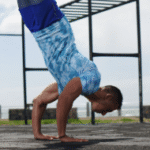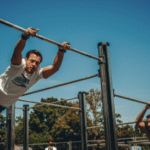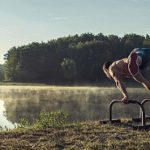Training Cycles (Periodization) in Private Calisthenics: A Coach’s Blueprint
In the world of calisthenics, especially in a city like Houston where the standard for fitness is high, simply “working out hard” will only get you so far. To progress from basic push-ups to advanced skills like the muscle-up or handstand, you need a plan. This is where periodization, or the use of strategic training cycles, comes in.
For a private calisthenics client, periodization is the master plan—the architectural blueprint designed by your coach to build your strength, skill, and resilience systematically. It’s the difference between randomly throwing bricks in a pile and methodically building a skyscraper. This guide will break down exactly what these cycles are and how your coach uses them to engineer your success.
What is Periodization and Why is it Crucial for Calisthenics?
Periodization is the logical and systematic planning of your training over a long period. Instead of doing the same thing every week, your training is broken down into distinct phases, or cycles, each with a specific focus.
This approach is especially critical in calisthenics for three key reasons:
To Prevent Plateaus: Your body is an adaptation machine. If you do the same workout for too long, it becomes efficient at it, and your progress stalls. Periodization constantly introduces new stimuli (changing exercises, reps, or intensity) to force your body to keep adapting and getting stronger.
To Manage Fatigue and Prevent Injury: Calisthenics, particularly advanced skills, places immense stress on your joints and connective tissues (wrists, elbows, shoulders). Training at maximum intensity all the time is a direct path to burnout and injury. Periodization intelligently manages this stress by building in phases of lower intensity and recovery.
To Systematically Build Skills: You can’t achieve a planche by just trying to do a planche every day. You need to build foundational strength, then specific tendon resilience, then positional awareness. Periodization structures this journey, ensuring you build the necessary components in the right order.
The Building Blocks: Understanding the Cycles
A private coach will structure your entire training plan using a hierarchy of three cycles.
- The Macrociclo (The “One-Year Plan”)
This is the big picture, the long-term vision for your training. It typically spans 6 to 12 months and is built around your ultimate goal.
Example Goal: “To achieve a consistent, 5-second freestanding handstand within one year.”
The Coach’s Role: The coach takes this ambitious goal and breaks it down into a series of logical, achievable phases.
- The Mesociclo (The “Monthly Blocks”)
These are the specific training blocks within your macrocycle, usually lasting 4 to 8 weeks. Each mesocycle has a distinct purpose that builds upon the last.
Example Mesocycles for the Handstand Goal:
Mesocycle 1: Foundational Strength & Conditioning (Weeks 1-6): The focus here is not on balancing, but on building the raw strength and endurance in the shoulders and core. Exercises might include pike push-ups, wall walks, and hollow body holds.
Mesocycle 2: Skill Acquisition & Positional Strength (Weeks 7-12): Now the focus shifts to the specific skill. Volume on general exercises decreases, and time spent on handstand-specific drills increases. Exercises would include wall-facing handstand holds, learning to bail safely, and balance drills.
Mesocycle 3: Realization & Peaking (Weeks 13-16): The goal here is to put it all together. Overall training fatigue is reduced to allow for maximum performance in freestanding attempts.
- The Microciclo (The “Weekly Plan”)
This is the most detailed part of the plan—your actual workouts for the week. It dictates the exercises, sets, reps, and rest periods for each session.
Example Microcycle during the “Foundational Strength” Mesocycle:
Monday (Push Focus):
Pike Push-ups: 4 sets of 6-8 reps
Dips: 3 sets of 8-10 reps
Hollow Body Holds: 3 sets of 30-45 seconds
Wednesday (Pull Focus):
Pull-ups: 4 sets of 5-8 reps
Rows: 3 sets of 10-12 reps
Hanging Knee Raises: 3 sets of 12-15 reps
Friday (Full Body & Handstand Prep):
Wall Walks: 3 sets of 3-5 reps
Bodyweight Squats: 3 sets of 15-20 reps
Plank: 3 sets of 60 seconds
The Private Coach’s Strategy: Choosing the Right Model for You
A key part of a private coach’s job is to select the right periodization model for your experience level and lifestyle.
For Beginners: Linear Periodization
This is the most straightforward model. You start with a block of higher volume and lower intensity to build a solid base, and then gradually, over several months, the volume decreases as the intensity (difficulty of the exercises) increases. It’s a safe and proven way to build foundational strength.
For Intermediates/Advanced: Undulating Periodization
This is a more advanced and highly effective model. Instead of keeping the focus the same for a whole month, the intensity and volume “undulate” or change within the week.
Example: For your push day, Monday might be a Strength Day (low reps of a hard exercise like handstand push-ups), while Thursday is a Hypertrophy Day (higher reps of a moderate exercise like dips).
Why it’s effective: This constant variation keeps the training stimulus fresh, which is incredibly effective for breaking through plateaus.
The Unbeatable Advantage of a Private Coach
While you can find periodized programs online, they lack the most critical component: auto-regulation.
A private coach doesn’t just write a plan; they adapt it in real-time. If you come into your session in Houston feeling drained from a stressful week at work or the summer heat, a good coach will see that and adjust the day’s training. They might reduce the intensity and focus on technique, or switch to a recovery-focused session. This intelligent, real-time management of fatigue is something a generic plan can never do, and it is the ultimate key to making consistent, injury-free progress.
Conclusion:
Training cycles are the science of long-term progress in calisthenics. A private coach acts as your personal scientist and architect, designing a periodized plan that is not only based on proven principles but is also perfectly tailored to your unique body, goals, and life in Houston. This strategic approach ensures that every workout is a deliberate step forward, transforming your ambitious goals into tangible achievements.

Training Cycles (Periodization) in Private Calisthenics: A Coach’s Blueprint
Route
Calisthenics Gym Houston Functional Bodyweight Training
Secondary phone: (346) 483-3195
Email: info@calisthenicsclubhouston.com
URL: https://calisthenicsclubhouston.com/
Monday 6:00 AM - 7:00 PM Tuesday 6:00 AM - 7:00 PM Wednesday 6:00 AM - 7:00 PM Thursday 6:00 AM - 7:00 PM Friday 12:00 PM - 6:30 PM Saturday 9:45 AM - 12:00 PM Sunday 3:00 PM - 5:00 PM





